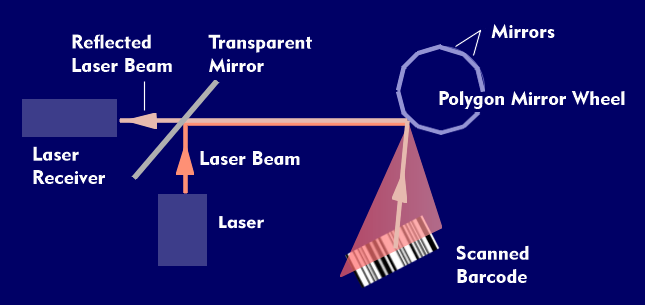laser scanner
Laser scanners scan objects in their surfaces and shapes. The scanned data is processed in a computer. When bar codes are scanned, they are used in goods logistics; when bodies are scanned, they are shown on corresponding displays as 3D graphics. Laser scanners are used in logistics, merchandise management, surveillance, architecture, nature and construction, process, railroad and automotive engineering, and people recognition.
The methods used in laser scanners vary somewhat depending on the application. In the case of bar code scanning, the aim is to scan the complete bar code with the laser beam and interpret the reflected laser light, whereas in the case of 3D scanning or distance measurement, the aim is to measure time differences.
When bar codes are scanned, a laser beam is deflected by a rotating mirror wheel with several mirrors, a polygon mirror wheel, and cast onto the bar code. As the mirror wheel rotates, the entire bar code is exposed by the laser beam. The light reflections off the bars and gaps in the bar code are reflected and transmitted via the polygon mirror wheel to the optical receiver, which processes the signal.
Laser scanning of 3D models and distance measurement differ in that a time reference must be established between the emitted and reflected laser beam. This method is based on the fact that an infrared light emitting diode emits short light pulses. These laser pulses have a pulse duration of a few nanoseconds (ns) and are emitted via rotating mirrors. Simultaneously with the emission of the laser pulse, the triggered pulse starts a timer that measures the duration of the light pulse traveling there and being reflected back. When the laser pulse hits an object, it is reflected and detected by the laser receiver. A photodiode converts the reflected laser pulse into an electrical signal that stops the timer. The time that elapses between the emission of the laser pulse and the reception of the reflected laser pulse is used for distance calculation. The angle calculation is done by the angle decoding of the rotating mirrors.
The light travel times are in the nanosecond range. For example, for an object at a distance of 25 m, they amount to 84 ns for the outward and return travel of the light pulse.
Laser scanners for automotive technology operate in the distance range between 30 cm and about 100 m. The horizontal monitoring angle is about 240°, the angular resolution is less than 1°. Vertically, the aperture angle is only a few degrees.
In automotive technology, laser scanners are used both for vehicle detection and in driver assistance systems such as Adaptive Cruise Control( ACC). In this application, they scan the driving environment and transform the detected objects and their speed into corresponding models.

